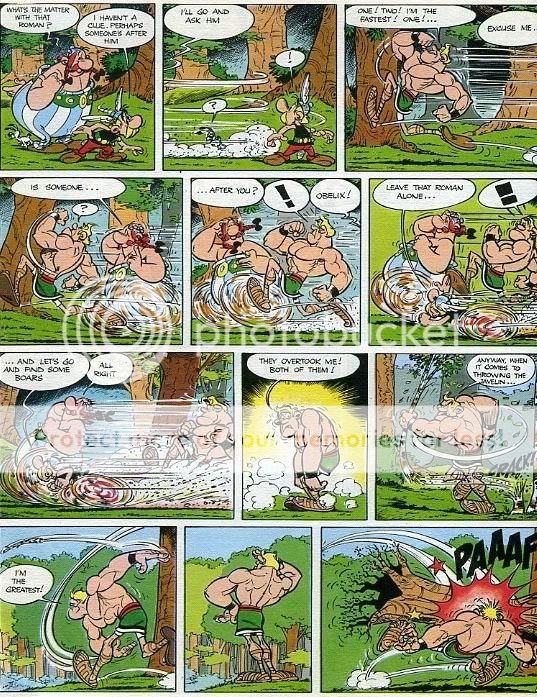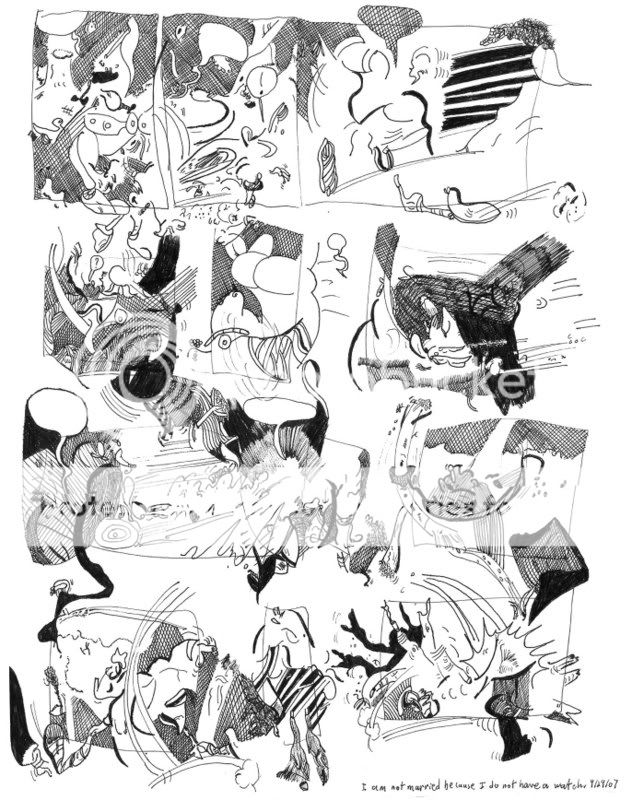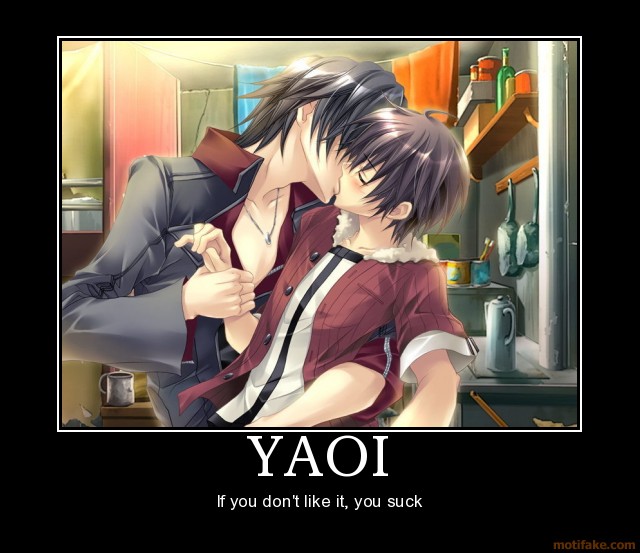I’m kind of swamped at the moment, so blogging will probably be minimal this week.
Monthly Archives: October 2007
Asterix and the Abstract Formalisms
As I’ve mentioned on the blog, I’m working on a series of abstract drawings based on comics pages from my youth. The most recent one I’ve worked on is a page from Asterix and the Olympic Games.
Copying the page has been a real eye-opener (semi-literally.) I first read Asterix when I was living in England during the third grade (my dad was on sabbatical at the time.) At that time, I probably liked Uderzo’s art well enough, but is was Goscinny’s (translated) stories — the manic, over-heated dialogue, the slapstick, the goofy puns, the running gags — which really appealed. For that reason, some of the later volumes, when Goscinny had died and Uderzo was doing the writing as well as the art — were especially unsettling. Everything looked right, but the writing was completely wrong: it was like seeing a corpse walking. The form was there, but the soul was gone.
Looking at the comic again, the writing is still marvelous, but I’m also amazed at the quality of the art. This sequence in particlar floored me:
The way the movement lines are incorporated as a composition element is lovely. The character occupying the left side of the panel is neatly balanced by the intersecting lines showing the circle of the hand and the flight of the sapling/javelin. Uderzo also narrows and twists the main big arc; looking at the lines, you can actually see the moment when the throwing hand turns over. The little puff and jump by the foot is eloquent — you can actually feel him hopping forward as he releases the javelin. Everywhere you look in the panel there’s movement, and your eye arcs from one path to the next. The position of the body is also amazingly well done, especially considering that this is a very cartoony figure. The twist of the torso, the slightly separated fingers of that left hand, the jaw lifted to watch the flight, and (again) that amazing little jump with the foot.
The body language in the second panel is perfect too. It’s narrower, so the figure is more centered, and it’s the first panel on the page with no movement lines, emphasizing that it’s a moment of stillness. The curve of the back and the cocky turned-out hand on the hip suggests the outthrust chest and the smirk that we can’t see. It’s a great pause for comic timing —followed by the climax, with all the comic tropes trotted out — stars, giant sound effect, stars, and impact effect. Again, the little detail of the puff of smoke and the movmeent lines by the feet kill me (and him!) The tightened hands are perfect, and I love the way that the left hand and foot are drawn on top of each other, so that at first it looks like his fingers are a blur. That roots on that tree he’s been bashed with are also really nice. And, of course, the movement lines showing the path of the tree mirror the ones in the first panel, as does the whole composition. Throw left-pause-bashed right: it’s a stream-lined, efficient comedic delivery system, professional in absolutely the best sense — as elegant as Bushmiller’s Nancy with, to my mind at least, a lot more energy and panache. After looking at it, I wonder if I should go back to those Uderzo-written volumes just for the art.
So, yeah, there’s nothing like trying to copy somone’s art to give you an appreciation of their craft (and the limitations of your own.) For those interested, here is the whole page, copyright Goscinny and Uderzo.
And here’s my version:
There’s a quote from my son in the bottom corner of mine: it says, “I am not married because I do not have a watch.”
Are Boys Safer?
Poking around the Internet I found this article by J.D. Ho on The Horn Book website which attempts to answer the age-old question why do girls love boys’ love manga. I think the question is a little overdetermined — why is any genre popular, after all? Super-heroes? Sci-fi? Isn’t it a little random that so many people are obsessed with tales about detectives hunting down a murderer? Any genre looks fairly arbitrary once you take a step back from it. As Ho does indicate, shonen-ai stories are extremely well-told and the art is excellent. Does there need to be another reason for people to read them?
In any case, the answer Ho comes up with, like the question, is familiar:
And herein lies the real appeal of boys’ love manga. It postulates that gender fluidity and change are ways we can identify with those who are different from us, experience new things, and, most importantly, achieve things that were impossible before. Just as in As You Like It, changing gender is liberating, an escape from parental strictures, and a means of getting the things one wants. We all need a safe place, a Forest of Arden, where we can try on different identities without consequence, a place where we can resolve our problems and face our fears — and boys’ love manga provides exactly that.
In other words, the appeal is that the reader can pretend to be something she is not, and so transcend her own boundaries and limitations in a safe space. Girls like to imagine boys because boys aren’t girls, and so the identification is safer and more fantastic. I think this line is especially telling:
If female readers are empowered by reading stories in which men are the romantic principals, they may derive the same feeling from stories in which gender is completely irrelevant in other ways.
So for Ho, the point of boys’ love stories and (as the essay goes on to argue) cross-dressing stories is that gender doesn’t matter, or is made irrelevant — it’s a way out of male/female binaries.
That position seems awfully questionable to me. Surely a large part of the appeal of boys’ love manga is that, you know, girls like boys. And if you like boys, why wouldn’t two boys be better than one? The fact that shonen-ai often blends into, or looks towards, the steamy sex in yaoi isn’t an accident these books are erotic. Girls like them because they’re romantic and sexy. If guys like to watch girls having sex (and they do), why wouldn’t girls like to watch guys having romance, followed by sex?
And ditto, for the gender-bending. Yes, experimenting with possibilities is liberating and exciting for the young girl coming of age etc. and so forth. But that liberation and excitement *are* liberating and exciting in large part because they carry a polymorphous sensual charge.
Boys’ difference isn’t safe — it’s sexy. Ho is writing on a site dedicated to children’s books, and I guess it’s understandable that they don’t want to tell the parents that little Sally reads these comics because she gets off on them. But I think she probably does.
Not sure if this is the illustrator or not, but I got this image from here.
Scott Treleavan
My arts correspondent Bert Stabler tipped me off to this artist, who is pretty great. Check out his work:
http://www.kavigupta.com/artists/treleaven/st_images.html
Are You Token To Me?
As long as I’m obsessively blogging about gender issues, I thought I might weigh on the conversation Valerie Dorazo and Dirk Deppey are engaged in. Dorazo argues that more gay characters in comics would be a good thing and that someday gay characters will be (or at least should be) as well, um, integrated into mainstream titles as black characters now are. Deppey responds by saying, eh, who cares?
I think this is basically an argument about tokenism, which makes it also an argument, to some degree, about segregation and isolationism. Dorazo believes that, overall, any more or less positive representation is good. It combats prejudice, normalizes marginalized groups, and leads to greater peace, equality, and happiness for all. And if I got a little sardonic there…well, it’s hard to take it entirely seriously when the model for success in comics is black folks, who remain massively underrepresented as characters, and even more underrepresented as creators. In fact, its hard to think of another segment of the entertaiment industry other than country music in which people of color are so thoroughly absent and marginalized — and this despite the fact that mainstream comics has been engaging in various forms of tokenism for the last what? 40 years or so?
Dirk’s essay, on the other hand, reminded me of a speech I saw by Aaron McGruder at the University of Chicago. McGruder was answering a question about why he had cut all the female characters out of his comic. He said that he had done so because he knew more about male characters. He also said that he didn’t think it made sense to insist that every creator represent or talk about every demographic. He added that in general he would just as soon not have clueless white people trying to write blacks. As an example, he pointed to Smallville, in which Superman’s best friend is black. “What on earth is a brother doing in Smallville?” he sneered.
It’s a pretty funny point, but also a big more double-edged than McGruder may have intended. It’s true that black people are more likely to live in cities than in small towns — but that’s not an accident. Nor is it due to the fact that African-Americans like cities better than do Caucasians or Jews. Rather, black people live in cities because of a history of segregation and racism. As James Loewen quite conclusively argues in “Sundown Towns,” blacks in the north used to be fairly evenly distributed in urban and rural areas. Then in the post-Reconstrution era, race relations became much worse, and blacks in a huge number of small towns were forced out by threats, lynchings, race riots, and other forms of violence. In defense, blacks congregated in cities, where the more anonymous nature of urban living and their relatively large numbers made them impossible to dislodge (though some cities did try.)
In other words, McGruder is mocking the idea of enforced integration, and using as his argument an example which points back to a history of enforced segregation. I think Dirk is doing something similar when he defends super-heteroness on the grounds that, hey, who wants to hear clueless straight dudes talk about gayness anyway? On the one hand, of course, he’s absolutely, and clearly, right. But why are comics writers so especially clueless about this issue? After all, there are a lot of super-hero comics about, say, environmental concerns which, while not especially or necessarily great, aren’t noticeably dumb by the genre’s standards of story-telling.
It seems to me that super-hero comics — in their content and demographics — are especially ill-suited to deal with gender and sexuality. Masculine bonding and masculine fantasy are at the core of what super-hero comics are about. I think that’s why tokenism is going to generally feel like tokenism. To deal with gay issues, you’d really have to work against genre expectations in some fairly conscious and intelligent ways.
So I guess I think that Dorazo is right in suggesting that the exclusion of gays in super-hero comics is telling and kind of icky. And I think Dirk is right in saying that tokenism is not likely to help matters much.
Further natterings on these issues:
Cerebus is gay
super-heroes are gay
if super-heroes embroidered, would it be gay art?




